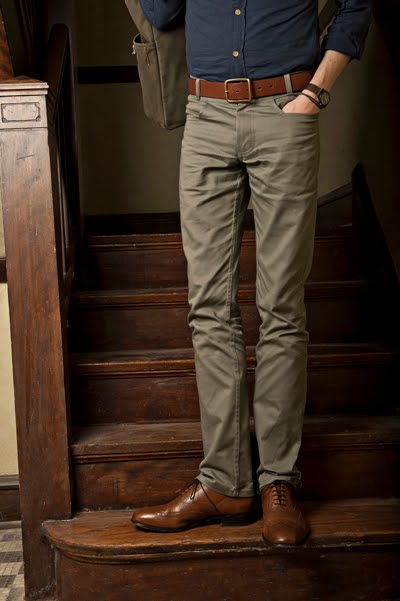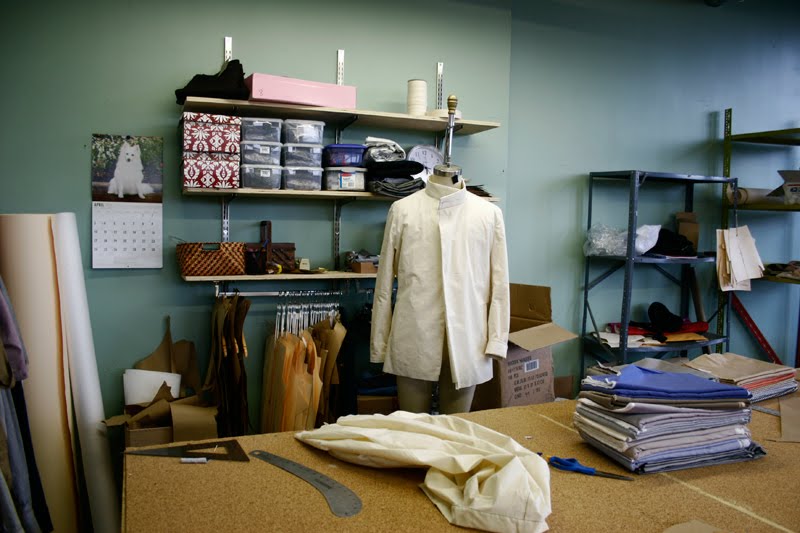
Meet Jonnie Rettele.
She's the mastermind behind Nonnie Threads, a small but remarkable menswear label that's designed fresh every season in a picturesque industrial space she shares with a few other entrepreneurial designers just south of Wicker Park. Behind each of Jonnie's designs is a story. These pieces are born out of rich traditions of American clothing, and with every new line, she channels a recognizable icon. Last year, it was Tom Waits. This year, Steve McQueen. You get the idea.
There are lots of reasons we love Jonnie Rettele. She's good at what she does. She tests her designs on her husband, Mustafa (score one for love). She's following her bliss, and she's passionate about clothing that's made in the U.S.A. And she sees that the American clothing industry needs a kick in the pants. She's challenging major players—shirting giants who have been around since the days when sailors were still kissing nurses in the streets. Yet, that doesn't phase her, because she's got a vision. And we like people with vision.
But here's the thing: America and quality, can be tough choices sometimes. And as good Midwestern boys, we grew up wearing hand-me-downs and having our mothers yank our hands down thrift store aisles. We still remember when we thought retail-priced jeans from American Eagle were a treat. But we're on a sartorial journey, which means that we're constantly evaluating—being thrifty most of the time, splurging on superiority some of the time, and trying to be sensible all of the time.
That's why we caught up with Jonnie at her studio—to test a couple of her pieces for ourselves and see if American-made quality is still worth the money.
 Midwestyle: So let's tackle the issue of quality clothing. A lot of guys are hesitant to support pricy American goods because they can get cheap alternatives elsewhere. What's the difference?
Midwestyle: So let's tackle the issue of quality clothing. A lot of guys are hesitant to support pricy American goods because they can get cheap alternatives elsewhere. What's the difference?
Part of it is also the environmental cost. It may be cheaper to import those materials, but it has hidden negative impacts other places, like the carbon footprint.
I used to buy pants from Zara, and after about 10 washes, the coloring would fade. That's something I try to do: Get my husband or people I know in the clothes so I can know how it's washing and know how it's wearing. I want to know exactly what this fabric is doing and be able to tell you.
And the details cost money: the seams, the stitching, the attention to detail. Those are difficult things to mass-produce. You're paying for a special piece; you're paying for a story.
MWS: What kind of story? You make a jacket that has a pretty interesting genesis, right?
JR: My father-in-law worked as a night security guard at Marshall Fields, and he started bringing all these coats over. They're just beautiful: amazing lining, amazing craftsmanship. I didn't realize that things aren't made that way anymore.
He used to save his money and buy two pairs of one type of coat in two different sizes. So, he's got this long leather coat with a shearling inside and a notched collar, and he bought it in a size 40 and a size 42. My husband's wearing the 40 now, and his dad's wearing the 42. He used to wear the 40 when he got it in the '60s or '70s.


MWS: Jeff and I were just talking about this the other day. Is timeless style something to shoot for?
JR: Clothing should last. A really inspiring element from my father-in-law is how he takes care of things. He gave us all these cashmere sweaters from Marshall Fields—probably 20 of them in different colors, crew-necks, V-necks, cardigans—and they were all individually bagged, perfectly folded.
I think that's something that men don't learn as much today—because everything is so expendable. You go to H&M or you go to the Gap, and "This is only a $20 shirt, so I don't really care if it gets a hole in it, or if I wash it with a dark color and it's a white; I'll just buy a new one." It's okay to spend the money on something if you're going to take care of it.
The story of Nonnie Threads just sort of happened, and it had a lot to do with being partnered with someone who was at point in his life that he wanted to start dressing like a man. And part of it was also being at the tail end of this long dry spell in menswear.

MWS: So what was it about menswear that pulled you in?
The energy from guys. Women are excited when they meet someone who's doing womenswear, but not as much guys when they meet someone who's doing menswear. It's not as common. And I think there was such a dry period in menswear in the past five years.
Trends don't move as fast as womenswear. There's a challenge because men will only go so far. I think they're getting more adventurous, which is good, and that can be a result of lots of menswear lines popping up and you have to do something different to stand out.
Then, all of a sudden, it's booming. The whole heritage movement has sparked that, where people are paying attention to where things come from.

MWS: What about here in the Midwest? When you think of menswear here, what comes to mind?
JR: Casual. You think of the West Coast, you think of board shorts and surfer wear. East Coast, you think of more tailored fashion. But the Midwest is casual. Maybe it's because a lot of us are from working-class farm families. I feel like sometimes the Midwest is really sheltered.
MWS: Last question. What's on the radar for menswear?
JR: I've been wearing vests since I was like in third grade, so I was really excited when vests came back in style. One thing I'm questionable about is the whole "bold color" thing. I don't think that will stick around as long as, say, the shawl collar. You'll probably see that for a number of seasons. Something I want to experiment with is more cowl necks with T-shirts. It's sort of peasant-y. Since there's so much more energy with menswear right now, I feel like there's a relevant need for having faster trends.




Great Q&A! I'm still learning the ins & outs of menswear & men's fashion, so this totally drew me in. Thank you! :)
ReplyDelete<3 The Daily Dani
Enjoyed reading the interview with Jonnie...she makes the best clothes ;)
ReplyDelete